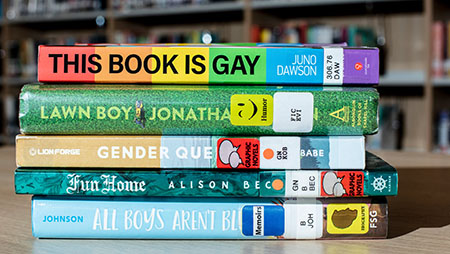by WorldTribune Staff, October 18, 2022
Having successfully inundated American classrooms and culture in transgender ideology, the Left’s next aim “is the sexualization of children,” a new analysis says.
“The Left uses several mechanisms to sexualize children. Public libraries, public schools, and book retailers must feature gender-bending books for ever-younger children, all with the aim of mainstreaming the fringes. Pride Month in June, 2022 featured drag shows aplenty, where young children danced with men dressed as sexualized women or put dollar bills in the pasties of strippers. Activists and academics are hard at work redefining pedophiles as ‘Minor Attracted Persons’ in order to reduce the stigma associated with the desire to have sex with children,” Scott Yenor and Anna K. Miller write for The American Mind on Oct. 13.
 One of the key mechanisms leftists will use for this goal is to normalize “porn literacy,” the analysis states. “Planned Parenthood and its government partners are already promoting porn literacy to school trainers and public health officials. It is late in the game already, though few people even know what porn literacy is.”
One of the key mechanisms leftists will use for this goal is to normalize “porn literacy,” the analysis states. “Planned Parenthood and its government partners are already promoting porn literacy to school trainers and public health officials. It is late in the game already, though few people even know what porn literacy is.”
Those pushing this approach believe that the leap from children watching porn to participating in porn will be much easier if children at school are taught to not only view all forms of porn, but view them as normal and not stigmatized, the analysis notes.
Parents of schoolchildren are beginning to take note of what the Left has been planning for quite some time.
In Dearborn, Michigan, Muslim and Christian parents have allied to pressure the local school board to remove what the parents said are pornographic books from district school libraries.
Dearborn is about 47% Muslim. One of Michigan’s most prominent faith leaders, Imam Hassan Al-Qazwini of the Islamic Institute of America in Dearborn Heights, said: “Some of those books are completely inappropriate for our children to read. Some of those books promote pornography. Some of them promote homosexuality. We don’t need this.”
Christian and Muslim parents have joined forces to protest a Dearborn Public Schools meeting in Michigan to protest the inclusion of “woke” LGBTQ+ books in schools that contain sexually explicit material. pic.twitter.com/5G0lz9Os8O
— Ian Miles Cheong (@stillgray) October 12, 2022
Kath Albury’s 2014 “Porn and Sex Education, Porn as Sex Education,” published in Porn Studies, is among the most widely cited porn literacy articles.
“The defense of teaching porn literacy begins with eliminating the stigma around watching porn, but ends with hopes to promote porn use and to encourage ever younger children to integrate porn into their increasingly active sex lives,” Yenor and Miller write.
According to porn literacy advocates like Albury, porn fosters social reform and teachers should press students toward a “framework of thick desires” under conditions of “equity, justice and care.”
Albury contends that children should experience pornography in order to reshape “the broader curriculum of formal sex and relationships.” The hope is to increase “young people’s sexual repertoires,” especially through the consumption of gay porn and community sex activities. Possibilities include exposure to bareback pornography (condom-less sodomy), and oral and anal sex. Few youngsters think of these things left to themselves, but exploring porn can help them open new horizons.
Many are following in Albury’s footsteps, the analysis noted.
“Planned Parenthood’s offshoot, ETR, standing for ‘Education, Training and Research,’ trains sex education facilitators. In a recent video used to train high school teachers in porn literacy, Sarah Diamond, Associate Director of Prevention Education at the University of San Diego, and her partner in porn pedagogy applied Albury’s scholarship to practical situations in classrooms,” Yenor and Miller write.
The analysis continues:
“Diamond and her fellow presenter offered three tips for educators on porn literacy that follow the scholarship precisely. Values must be clarified at the outset. Facilitators cannot begin open conversations about porn in classes if they think ‘watching porn and by extension sex work is inherently bad.’ Instead, facilitators should aim at a neutral approach to porn. An anonymous survey about porn accomplishes this goal. The teacher collects the surveys and then hands them out to different students at random. Students will be asked to defend whatever proposition about porn is on the survey that they receive. This allows students to defend positions on pornography, whether they wanted to or not. The hope here was to mainstream discussions about porn as a normal activity, like talking about Homer or discussing the American Revolution.
“Critical thinking skills on porn was the second teaching tip. The trainer hopes to cultivate an appreciation for how porn cultivates sexual excitement and sexual fantasy. She recommends talking to elementary students about porn so that they are not shocked by it but rather can learn how to integrate what happens on the screen into their own chosen lifestyles. The third tip involves how to reduce shame attached to watching pornography. To watch porn is human, because human beings like to watch other human beings have sex. This should be integrated into everyone’s life to keep things honest.
“By mainstreaming porn discussions, teachers destigmatize porn (insofar as it is stigmatized) and treat it as just one legitimate option among many. Some people like Coca-Cola. Others Pepsi. Others BDSM. Whatever.”
Yenor and Miller note that the porn literacy movement in U.S. schools is “moving toward the educational mainstream, embraces the idea of children watching many varieties of pornography. Children should watch it. Should they participate in it? That is against the law (for now), but perhaps there are additional ‘indirect strategies’ to get around such prohibitions.”
Action . . . . Intelligence . . . . Publish
